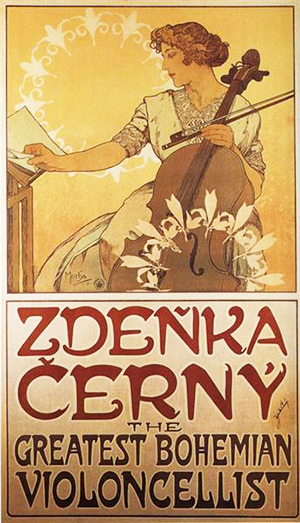Paris, fin-de-siecle, the Belle Epoque is in full swing and the city is full of talented artists. The poster craze is under way; the boulevards are adorned with suggestive, artistic posters, mostly the delightful artwork of Alphonse Mucha, the Czech artist who created Art Nouveau.
Mucha's splendid portrait of Zdenka Cerny was to be used to promote Zdenka's scheduled tour of Europe the following year but, due to the outbreak of war, the tour was cancelled.
Consequently very few prints of the poster were produced, which no doubt adds value to them. Last year an original lithograph in perfect condition was auctioned in New York for about $5000 (unverified), and another auction at the end of October expects to realise $4000 for an original poster (slightly creased).
Alphonse Mucha in Chicago
At the height of his fame, Alphonse Mucha was commissioned to do a poster for the Louisiana Purchase Exposition of 1904. This project lead to a trip to the USA; he visited New York, Boston and Chicago.
The following year he returned to Chicago, staying with his friend A.V. Cerny, a well-known Czech musician who had founded the Bohemian Conservatory of Music there.
Mucha prospered in Chicago: he taught at the Chicago Institute of Art, gave lectures, put on exhibitions, and was always in demand at social events. He was even commissioned to design containers for perfumed soaps, which were marketed with his name: Savon Mucha.
Zdenka Cerny
Mucha's friend, Cerny, had three musical daughters. The middle daughter, Zdenka Cerny, shared her father's instrument; she was a promising cello-player from an early age.
When she was seven, Mucha promised her that he would paint her portrait when she became a real virtuoso on her instrument. She had no trouble keeping her part of the bargain.
By her sixteenth birthday she had become known as “The Greatest Bohemian Violoncellist” and Mucha gladly painted her portrait in 1913. Working mostly from a photograph of Zdenka, he painted her in action, playing her cello, turning the music page, her expression rapt and spiritual.




